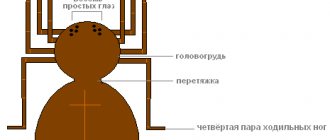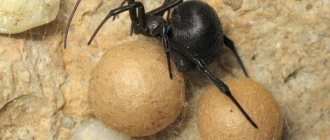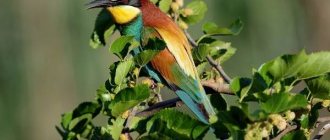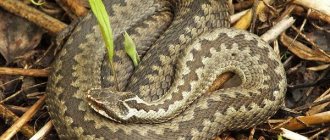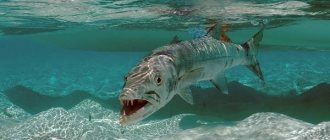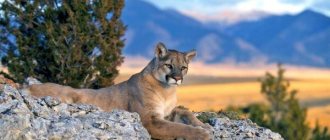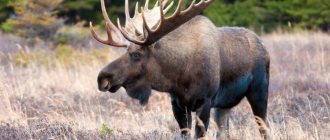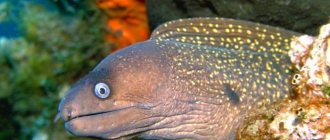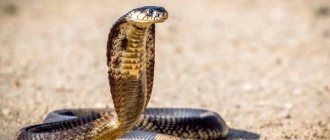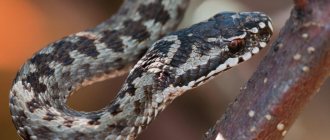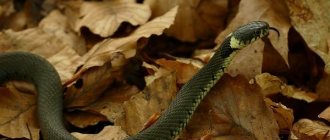Spiders usually evoke either subconscious horror or disgust in most people. Arachnophobia, oddly enough, is common to many people. Theoretically, because spiders are poisonous. But! Of the several thousand of their poisonous varieties, at most one and a half hundred are scraped together, the rest are safe for people. The second explanation is the disgusting appearance. However, the most dangerous spider, the tarantula, resembles a plush toy. And his small fellow tribesman, Argiope Brünnich, generally has an elegant, almost festive appearance. So arachnophobia is something irrational, and spiders themselves are worthy of attention and interest, like any other work of nature.
Description and features
To describe the appearance of Argiope, we need a number of special “spider” terms.
1. First, let's introduce you to the concept of chelicerae. If translated from ancient Greek, you get two words - claw and horn. This is the first pair of limbs, or jaws, of arachnids and other arthropods. They are located in front of and above the mouth.
They usually look like claws and consist of several segments. At the tip of such claws there are ducts of poisonous glands. Now we can explain who araneomorphic spiders are - their chelicerae are located towards each other, and they fold together, sometimes overlapping one another. Such chelicerae are designed to attack large prey, sometimes larger than the hunter himself.
2. The second important term in the description of spiders is pedipalps. Translated from ancient Greek, we get two words again - leg and feel. This is the second pair of limbs, the pedicles, located on the cephalothorax (called the prosoma in chelicerates). They are located on the side of the chelicerae, and behind them there is a second pair of walking legs.
“Dismembered” into several segments, like phalanges. Adult male spiders use every last segment of the pedipalp at the moment of copulation with the female. They are transformed into a kind of sexual organ called the cymbium. It is used as a reservoir for sperm, as well as for directly introducing it into the female's genital openings.
3. And the last complex concept is stabilimentum (or stabiliment). This is a prominent thickening on the web. Usually made in the form of a zigzag weave of numerous threads at the center. There can be one, two, three or more such pronounced thickenings, depending on the type of spider.
It can be vertical in the form of a line, it can go in a circle, or it can be in the shape of a cross. Moreover, this cross is made in the form of the letter X. A very important thing for spiders, as you can see, since they constantly make it on their web. Its exact purpose has not yet been studied by people, despite numerous attempts.
Argiope weaves very strong webs that can trap medium-sized grasshoppers
Perhaps it attracts the attention of the victim, or, conversely, scares away enemies, or disguises a spider in its background. There are so many versions! The version about attracting victims is closest to the truth, especially since the purpose of the web itself is a trap. By the way, it is the stabilimentum that is best visible in ultraviolet rays, which many insects “see”.
Some spiders initially had a linear shape of the stabilimentum, but over time it became cruciform, which also speaks in favor of the version of luring prey. As they say, they do any “tuning” to achieve the desired goal.
Externally, spiders look like this:
The abdomen is entirely covered with transverse stripes of lemon and black color, with light gray stripes between them. Closer to the cephalothorax, the color completely becomes pearl gray or brown. The prosoma itself is entirely covered with a velvety-silver undercoat.
The head is black and there are four pairs of eyes on it, different in size: 2 pairs of small eyes at the bottom, 1 medium pair of large eyes looking straight ahead and 1 pair of eyes, medium in size, on the sides of the head. It also has eight paws, arranged in pairs, the first and second being the longest. The third is the shortest, and the fourth is average.
Due to its bright coloring, Argiope is called the wasp spider or tiger spider.
The size of Argiope is not the largest among spiders, but nevertheless noticeable. The females are large, body length up to 3 cm. And with the length of the legs they reach 5-6 cm. The chelicerae are small. The shape of the body is closer to an oval, the length is twice the width. There are spider warts on the abdomen. These are the organs that form the arachnoid web. This was a female Argiope that was described.
“Men” are several times smaller than “ladies”; they grow up to 0.5 cm. They look inconspicuous and, in the literal sense, gray - they are most often mouse-colored or black, without any stripes. The cephalothorax is usually without hairs, the chelicerae are even smaller than in females.
The family of orb-weaving spiders (Araneidae), which includes Argiopes, is characterized by the production of a large circular network - a catcher's web. The main radial threads are thicker; a thread running in a spiral is attached to them.
The space between us is filled with rosettes in a zigzag pattern. Argiope's web is vertical or at a slight angle to the vertical axis. This arrangement is not accidental; spiders are excellent catchers, and they know how difficult it is to get out of a vertical trap.
Login to the site
This small spider has many names - spiny spider, spiny orb spider, horned spider, etc. The thing is that along the edges of its wide abdomen there are 6 spines (“horns”), which give the spider a rather menacing appearance.
Spiny orb-weaver spider, Horned Spider)
These spiders are common in tropical and subtropical zones. They can be found in the southern part of the USA (from California to Florida), in Central America (Jamaica, Cuba, Dominican Republic), South America, the Bahamas, as well as in Australia and the Philippines. As we can see, their habitat is quite extensive. They weave their nets in bushes and trees near swamps and streams.
The appearance of the spider is very unusual. The spider is wider than it is long. So the length of the female’s body is 5-9 mm, and the width is 10-13 mm. These spiders have pronounced sexual dimorphism, i.e. females are several times larger than males. Their body length is only 2-3 mm. Unlike many species of spiders, the horned spider has short legs.
Spikes along the edge of the abdomen
Male spiny spider
Female spiny spider
Spiny spiders attract attention not only with their unusual body proportions, but also with the variegated coloring of their abdomen. It can be white, bright yellow, red, black, etc.
Their colors depend on the species and habitat. The legs, shield and lower part of the abdomen are black with white spots under the belly. In males, the lower part of the abdomen is gray with white spots.
Yellow color
White color
And even this color
On the outer part of the abdomen there is a peculiar pattern of black dots, which are arranged in 4 rows. All of them have a mirror arrangement according to the vertical axis of the body. Does this drawing remind you of anything?
Like Jackson's mask?
There are six spines along the edge of the abdomen. They are also called "backbones". They can be black or red. In males they are not so pronounced, and their number may be less - 4-5 spines. They give the spider a more intimidating appearance, which helps scare away potential enemies. Otherwise, they can become quite a tasty snack. In addition, hard thorns make it difficult to swallow their owner.
They feed on small insects that they catch in their nets. The spider trap is a fairly strong net, reaching a diameter of 30 centimeters. They have an almost perfect circle shape, in the middle of which there is a thin network. It serves as a base for the spider. Only females weave webs. The males are located nearby, hanging on several threads.
Spiny spider webs
Central part of the web
It is interesting that if these spiders live in a small group, then the caught prey is divided among everyone, regardless of whose net it fell into. But most often they live alone.
As for the reproductive process, scientists still do not understand whether these spiders are polygamous or monogamous (the female mates with one male or several). In nature, sometimes you can see females with up to 3 hanging males around the web.
The male notifies the female of his presence by making peculiar taps on the network. After fertilization, he dies 6-7 days later, unless he becomes the female’s lunch immediately after mating.
Horned Spider in Macro (Gasteracantha cancriformis) from iChip on Vimeo.
The female begins to weave a cocoon on the inside of the leaf not far from the web, into which she then lays from 100 to 260 eggs. After this, she also dies. Thus, the life expectancy of these spiders is short: for males - up to 3 months, for females - up to a year. Spiders are born in winter. They grow up in 2-5 weeks and scatter in different directions.
The bite of this spider can be painful, but not dangerous. There may be slight redness and swelling at the site of the bite.
Spiny orb spider or “horned spider” (lat. Gasteracantha cancriformis)
Kinds
The Argiope spider is a genus of araneomorphic spiders from the family Araneidae. There are about 85 species and 3 subspecies in the genus. More than half of the varieties (44) are observed in the south and east of Asia, as well as on the adjacent islands of Oceania. 15 species live in Australia, 8 in America, 11 in Africa and its adjacent islands. Europe boasts only three species: Argiope trifasciata, Argiope bruennichi, Argiope lobata.
- Argiope trifasciata is perhaps the most common species on the planet. It was first described by Per Forsskol in 1775. In Europe, it is observed on the Perinean Peninsula, the Canary Islands and the island of Madeira. The greatest activity is in September-October, when the summer heat subsides.
- Argiope bruennichi ( Argiope Bruennichi ) The name was given in honor of the Danish zoologist and mineralogist Morten Trane Bruennichi (1737-1827), who discovered it. By the appearance of this spider one can make a description of the entire genus of Argiope. The dorsal pattern of the abdomen in the form of black and yellow stripes has led to it being called the argiope wasp spider . In addition, it is also called the zebra spider and the tiger spider.
Sometimes it is also called Argiope three-striped , based on the number of yellow stripes on the body. And of course, we are talking about females; we already know that men do not have such brightness. A characteristic feature is that it spreads with the help of its own web, flying on it on air currents. Therefore, it can be found not only in the southern regions, but sometimes much further north than usual. As they say, whichever way the wind blows.
More often it inhabits desert dry places and steppes. If we clarify the geographical location of populations, we can list;
- Europe (southern and central);
- North Africa;
- Caucasus;
- Crimea;
- Kazakhstan;
- Central and Asia Minor;
- China;
- Korea;
- India;
- Japan.
- In Russia, the northern border passes beyond 55ºN. Most often found in the Central and Central Black Earth regions.
Perhaps due to general climate warming, this spider is moving further north. He is comfortable in meadows and roadsides, forest edges; he chooses sunny and open places. Does not like moisture, prefers dry areas. Settles on shrubs and herbaceous plants. The wasp spider has two stabilimentum in its web; they are located linearly opposite each other, like radii from the center of the web.
Argiope spider is small, maximum size is about 7 cm.
- Argiope lobata ( Argiope lobata ) reaches a size of up to 1.5 cm in females. The abdomen is white and silvery with six deep indentations-lobules, the color of which varies from dark brown to orange. Due to this, it is also called argiope lobata . The web is in the shape of a wheel, the center is densely woven with threads. On the territory of the former Soviet Union, it lives in the Crimea and the Caucasus, in Central Asia and Kazakhstan and, of course, in the European part. Also found in Algeria (northern Africa).
- I would like to highlight one more species in this genus – Argiope ocular. Outwardly, he does not look like his relatives. Its abdomen is red, without yellow-black stripes, and its legs are also red. On the legs, the last two segments are black, with one white segment in front of them.
All covered with hairs, on the cephalothorax they are silvery. Lives in Japan, Taiwan, mainland China. This species, in addition to external characteristics that are uncharacteristic of the genus, is distinguished by one more quality. They often have males that survive without both segments of the pedipalps. In other words, after the second intercourse. And this is a huge rarity in the world of spiders. We'll tell you why a little later.
Argiope - black and yellow striped spider (Argiope bruennichi)
Let's start with the fact that argiope
- the name of an entire genus from the family of orb-weaving spiders, which according to various sources includes from 80 to 150 species, but here we will only talk about one of its representatives - Argiope Brünnich (the specific name is in honor of the Danish zoologist).
Argiope Brünnich
along with - one of two types of argiope, widespread throughout Russia and Europe.
Friends! personal request
ZooBot group on VK
About spider bites.
According to my data, argiope is safe for humans, although it may bite a little when protected.
However, see the comment below from a bite victim under the username Lexus
. Quite an unpleasant story. My opinion is that the case is atypical; most likely, it was the reaction of a specific organism, or there is a chance that the victim incorrectly identified the offender. However, an obvious moral follows from this: although the argiope bite is safe, it is better not to try it on yourself.
Lives in forests and meadows, spreading its nets in the grass and low bushes. Their main prey is fillies and grasshoppers, however, they also do not disdain flies.
Sexual dimorphism
clearly expressed: females are large and beautiful (in fact, all the photographs given here by me depict females), males are small and pathetic, inconspicuous, so that, unlike females, they are not so easy to track down and capture, so that solely for the sake of completeness, I present here
a photo of a male Argiope
, taken from Wikipedia:
Relationships between the sexes
in Argiope are extremely simple: after mating, the male
is eaten
(instead of a post-coital cigarette... feminists, have you already fallen in love with Argiope?)
According to some reports, the male can sometimes break out of the cocoon carefully woven around him during proximity, but he certainly will not leave the second female (and well, everything is like with people).
Please note: the Argiope network has a characteristic zigzag path called a “stabliment”:
The stabilization is clearly visible in UV rays, which attracts insects (oh, I’ll have to check this with a UV flashlight when the opportunity arises)
. Its presence indicates that the web manufacturer belongs to orb-weaving spiders.
Life cycle of Argiope
- 1 year. Small spiders hatch from eggs laid in spider lilies, in which they overwinter, growing up only by the next summer.
Please note: the arachnoid wart (protrusion on the abdomen) with the cobweb already glued to the leaf is clearly visible - you never know, what if this guy with the camera suddenly starts acting up and will have to urgently evacuate? And the rope is already prepared!
Well, that’s probably all about the black and yellow striped Argiope spider. Remember it, and know that this is not karakurt - there is no need to exterminate it, it is safe
.
But it’s also not worth going to the other extreme and tormented by remorse for the destroyed spider webs that you collect on yourself while walking through the meadow. about an hour to create another masterpiece to replace the one lost through your fault.
.
Although this creature is cute, it inspires inner anxiety. Some kind of unreasonable fear. It is especially creepy to watch how a spider with yellow stripes, also called a wasp, deals with defenseless grasshoppers and flies. He sets out a trapping net, sits half asleep, and waits. But as soon as the careless insect comes into view, it immediately transforms - it quickly pounces, paralyzes the victim with poison and deftly packs its “lunch” into a cocoon of cobwebs. Is it dangerous for humans?
Lifestyle and habitat
Argiope lives everywhere except the Arctic and Antarctica. It builds webs in spacious places where there are a lot of flying insects and, therefore, potentially good hunting. In addition, the chosen location should be clearly visible at any time of the day. Another plus in favor of the “attractive” role of the web and stabilimentum in the center. The weaving process takes only about an hour, usually in the twilight evening or early morning hours.
Usually the spider does not make any more shelters near the web, but sits in its center. Most often this place is occupied by a female. She spreads her paws in different directions along the web, visually resembling the shape of the letter X, waiting for prey. Argiope in the photo looks both beautiful and dangerous at the same time.
Beauty is created by a finely spun web, a spreading, motionless pose in the shape of a cross, and, of course, a bright color. Only this brightness is frightening. As you know, in the animal world there is a principle - the brighter, the more poisonous and dangerous. Cute and harmless creatures always try to be more invisible in nature.
Sometimes, sensing danger, spiders quickly move along the threads, hiding from predators. Others quickly “fall” to the ground with their belly up, which becomes darker and more inconspicuous due to the reduction of special cells. They always have a saving thread ready in their spider warts, on which they quickly fall to the ground.
During the day he is lethargic, apathetic, in the evening he begins an active, promising life. In a home terrarium, the spider needs to sprinkle coconut shavings or any substrate for spiders on the bottom, which needs to be changed periodically.
And place several branches inside, preferably grape branches, on which he will weave a web. The walls of the terrarium also need to be regularly wiped with an antiseptic to remove fungi and other bacteria. Just don't disturb his secluded places.
Nutrition
The Argiope's fishing net is distinguished not only by its beautiful shape and design, but also by its meticulous execution. In particular, the small size of individual cells. Even the smallest mosquito cannot break through such “windows”. Therefore, her lunch consists of unfortunate insects that got caught in this net.
It feeds on Orthoptera and various other insects. These are grasshoppers, crickets, grasshoppers (locusts), butterflies, midges, quails and jumpers. And also flies, bees, mosquitoes. The victim does not see the spider, or mistakes it for a wasp that is hovering in the air. The spider in the center of the web often repeats the shape of the stabilimentum and merges with it, only the striped body is visible. The prey begins to fight in the web, the signal thread gives a sign to the predator.
Argiope envelops prey in a cocoon and bites the victim
He quickly runs up to his prey and injects his paralyzing poison. Then he wraps the poor fellow in a cocoon and drags him to a secluded place. After a short time, it draws out juices from the body that has begun to dissolve. By the way, at home he eats the same as in captivity. Food should be given once every two days. Just, despite his love for dry climates, do not forget to give him water. And sometimes spray water into the aquarium on especially hot days.
Argiope Brünnich: keeping in the house
Thanks to the spectacular appearance of the female, the spider attracts the attention of lovers of exotic pets. Some people keep such a spider as their pet.
To keep Argiope at home, you need an aquarium in which the lid and one of the walls are covered with a fine mesh. Dry grape branches can be placed inside. They need to be sprayed only on the hottest days.
It is better to keep one spider in the aquarium, because if there are several of them, they will begin to attack each other, which will lead to the death of one of them.
You need to feed the spider once every 2 days. Various insects are suitable as food; they can be bought at a pet store.
Reproduction and lifespan
They become ready for procreation immediately after the last molt. At this time, in “girls” the chelicerae are still soft. During mating, the girlfriend wraps the partner in a web, and if he cannot then free himself, his fate is unenviable, he will be eaten. By the way, I would like to voice a certain theory about the notorious cruelty of female spiders here.
There is an assumption that the male deliberately gives himself up to be torn to pieces, supposedly thereby consolidating his position as a father. The female, having eaten the body of the unfortunate admirer, becomes satisfied and does not look for more adventures, but calmly engages in fertilization. It turns out that she herself is not against keeping the sperm of this particular applicant in herself. This is such “monstrous love”.
As a mother, she then performs at her best. She weaves a large cocoon, which is located not far from the main web, and hides eggs in it. Outwardly, these “nurseries” resemble the seed capsule of a certain plant. There are up to hundreds of eggs in a cocoon. The mother carefully guards the cocoon.
Argiope weaves a kind of cocoon in which about 300 eggs are kept and overwintered.
Children leave the “nurseries” at the end of August – beginning of September and actively disperse through the air on spider webs. There is another option for the development of events. Sometimes the spider lays eggs in late autumn and leaves this world. And the spiderlings are born and fly away in the spring. The life of Argiope is short, only 1 year.
Danger to humans
We immediately warn those who are interested in extreme sports - if you touch the web of an argiope with your hand, it will react and will definitely bite. Argiope's bite is painful and can be compared to a wasp or bee sting. This spider has very powerful jaws; it can bite quite hard.
In addition, we must not forget about its poison. Many people are interested in the question: is argiope poisonous or not ? Of course, it is poisonous; it is with this toxin that they provide themselves with food by killing their victims. Has a paralyzing effect on invertebrates and vertebrates.
The second question is that the poison is not dangerous for humans and large animals. Spider venom contains argiopine, argiopinin, pseudoargiopinin, but in small doses that do not pose any particular harm to humans.
The consequences of this bite are not fatal, but can cause a number of significant inconveniences and troubles. Most people experience redness and slight swelling near the site of the bite, which goes away within a couple of hours.
But it happens that these signs disappear only after a day, and the bite can be very itchy. But if you have a weakened immune system, have an allergic reaction, or have a child with you who has been bitten by a spider, then the consequences can be unpleasant:
- The bite site swells noticeably;
- Body temperature rises, sometimes quite significantly, up to 40-41 degrees;
- Nausea and dizziness begin.
There is only one way out - immediately see a doctor. No “it will go away later” or “I’ll heal myself.” Don't risk your life. And as first aid, cauterize the bite site and give an antihistamine. And drink plenty of water.
The benefits and harms of the spider
As we have already said, this spider does almost no harm to humans. If you don't offend him yourself. It just litters open spaces with its web, slightly interfering with a carefree walk. But this is not a harm, just a minor inconvenience.
But it has great benefits. It can catch up to 400 harmful insects in its nets per day. Therefore, do not rush to destroy them if you see them in a meadow or forest edge. In the forest, in the garden or in the vegetable garden, these tireless orb weavers weave their nets and catch springtails, leaf rollers, bugs, aphids, caterpillars, mosquitoes, flies and other harmful insects in them.
Spiders are voracious; in a day they eat as much as their own weight. So consider how much benefit this ecological insect trap can bring over the summer. In addition, according to ancient Eastern philosophy, the spider brings good luck.
Argiope bites are painful, but not capable of causing significant harm to humans.
Birds of Siberia
The territory of Siberia has traditionally been represented by two geographical parts - Western Siberia and Eastern Siberia. The region is distinguished by a large number of feathered predators, small and nimble birds, as well as long-legged beauties, including the Far Eastern stork.
Stork
A fairly large bird with long legs, a high neck and a long elongated beak. White and black storks live in Siberia. The average weight of a white stork is 3.5-4.0 kg. The legs and beak of the bird are red in color. The adult female differs from the male in smaller stature. One nest is used by such monogamous birds for several years. Storks begin to breed at the age of three.
Golden eagle
A falcon-like bird from the hawk family has long and rather narrow wings, as well as a slightly rounded tip of the tail. The golden eagle is distinguished by strong paws with fairly large claws. In the occipital region of the head there are small and pointed feathers. The average length of a bird varies between 80-95 cm, with a wing size of up to 60-72 cm and a weight of no more than 6.5 kg. Females are larger in size.
Thrush
A representative of the Thrush family and the Passerine order, it is small in size, ranging from 20-25 cm. The bird moves along the ground in small jumps. The thrush's nest is very large and strong, made using clay and earth. Northern varieties of thrush go to the southern territories for the winter. The male thrush has black plumage, while females have dark brown feathers with a light throat and a rufous chest.
Bustard
The rather large bird is quite rare in Russia and is on the verge of extinction today. The bustard resembles an ostrich in appearance, is distinguished by strong legs with no feathers, has a high neck and a head with a small beak. The color scheme is represented by red and white tones. The average body length of adult males reaches 100 cm, with a weight of about 18 kg.
Lark
The bird is a representative of the order Passeriformes and the Larks family. Such birds settle in open space, preferring fields and steppes, forest clearings and alpine meadows. Larks are distinguished by rather long and wide wings, small legs with a large posterior nail. The color of the plumage directly depends on the species characteristics of the bird.
Finch
The songbird from the Finaceae family prefers light deciduous and mixed forests and is found in groves and oak forests, gardens and park areas. With the onset of winter, the inhabitants of the territory of Siberia fly to warmer regions. The finch has a thin, conical beak. The plumage of males is predominantly black-brown with white stripes. There are greyish-blue feathers on the top of the head.
Kobchik
A representative of the Falcon family is common in taiga areas. This rare species is distinguished by its relatively small size. Females are usually larger than males. The falcon has a small and insufficiently strong beak, characterized by relatively small and rather weak fingers with small claws. The plumage of this rare bird is not too rigid, but more loose.
Lun
A bird from the Accipitridae family is a rare species, whose representatives have a body length in the range of 49-60 cm, with a wingspan of no more than 110-140 cm. The average weight of an adult bird varies between 500-750 grams. The western species has gray, white and brownish plumage. Flying birds move at low altitudes. Nests are located in wetlands, with the presence of reeds and reeds.
Osprey
Osprey is a large representative of the Falconiformes order and the Skopinae family, distinguished by black and white wing plumage. The bird is listed in the Red Book. A distinctive feature of the feathered predator is the presence of sharp tubercles on its fingers, which are used when grasping fish. The upper part of the body is black, and there are white feathers on the head. The wings are long, with noticeably pointed ends.
Interesting Facts
- In Japan, spider fights are held, and this particular type of spider often appears there.
- In some people, spiders cause an excessive fear, which is called arachnophobia. This feeling arises at the genetic level, coming out of the most ancient times, when almost all arachnids were dangerous. Argiope does not have such dangerous qualities; she is more attractive than scary. However, people with the above-described disease should not get it.
- After mating, males often cut off the cymbium (the last segment of the pedipalp), this is called autotomy (self-cutting of the organ) at the moment of mating. Probably to escape in time. This embolus (fragment), sometimes with additional segments, clogs the female's genital opening. Thus, if this male manages to escape from the cannibalism of the female, he can impregnate one spider again. After all, he still has one more cymbium left. But most often they do not survive after the second mating.
- The Argiope spider is one of the fastest weavers. It creates a network with a radius of up to half a meter in 40-60 minutes.
- It is instructive that “Indian summer” with cobwebs is the time of settlement of young spiders. They are the ones flying on their “air mats” when this wonderful time begins.
- During archaeological excavations in Africa, a web about 100 million years old was discovered in frozen amber.
- Argiope spiders use a “fragrant” bait for victims. This assumption was made by Australian scientists after conducting a series of experiments. He applied a solution of putressine, which the spider uses to “flavor” the thread, onto the surface being examined. The catch doubled.
Skilled braiders
Like all web spiders, Argiope Brünnich prepares traps stretched between blades of grass and low branches of bushes. The networks of this species of arachnids are circular, in the center they have a zigzag-like pattern, characteristic of the weaving of all brothers in the genus Argiope and called stabilimentum. Despite the small size of the hunter, his traps are very durable, capable of holding a grasshopper, which is 2-3 times larger than the predator. Argiope Brünnich spends only an hour creating nets that are woven at sunset, in the approaching twilight.
